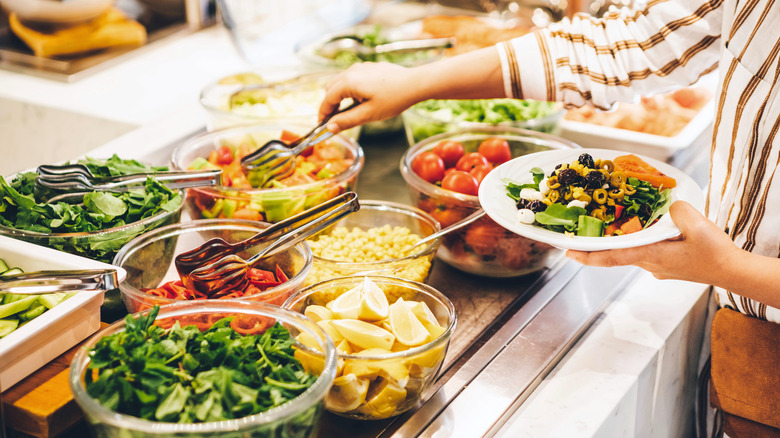The Easily Avoidable Mistake That Makes Your Salads Unappetizing
A simple salad of leafy greens and dressing can be successful. But, that's not to say that humble salads can't be improved upon with a few extra ingredients like a serving of fresh vegetables, crunchy croutons, toasted nuts, or the like. Just be warned that there is such a thing as introducing one too many toppings. In fact, an abundance of ingredients could be the very thing that's standing in the way of making a better-tasting salad — let us explain.
Variety is the marker of an exceptional salad. Yet, while salad should boast a medley of flavors, textures, and colors, it shouldn't contain dozens of different ingredients. Though it can be tempting to layer in any and all of your favorite toppings as you scan a salad bar or raid the inside of your fridge, combining an assortment of mismatched ingredients can ruin a bowlful as contrasting flavors will clash, resulting in a muddled and unappetizing bite. The good news, however, is that this salad faux pas can easily be avoided so long as you take a more minimalist approach when crafting salads from scratch.
The ultimate way to ensure a harmonious and well-rounded forkful is limiting the number of ingredients to add. Relying on a handful of ingredients can give each component a better opportunity to shine. Of course, using ingredients sparingly isn't the only thing to consider when making a stellar salad.
A guide to making better salads
Depending on preference, the ideal ratio of lettuce to toppings may vary. That said, the best salad recipes should include five main components. Along with a base of greens or grains and a splash of dressing, each bowlful should consist of some sort of fresh produce, a protein, and an interesting — ideally, textured — extra. By selecting one or two ingredients per category, salads will have depth without jeopardizing balance. The trick is simply knowing good combinations of toppings to pair together.
When making a salad with a pared-down ingredient list, choosing the right mix of add-ins is essential. Aside from opting for quality produce, it's wise to seek out ingredients with complex profiles or that have undergone techniques like toasting, caramelizing, or pickling as this can maximize flavor tenfold. But, no matter which toppings you plan to introduce to salad, make sure that flavors remain as cohesive as possible. Rather than throw together myriad random toppings, think about how their flavor profiles will interact. In fact, it can even be helpful to build a salad around a specific culinary theme.
Some of the most famous salads offer a good example of less is more. Take Caesar salad: Bread, lettuce, anchovies, parmesan, dressing, and sometimes the addition of chicken. It's simple but with contrasting flavor and textures. Likewise, a core Waldorf salad just contains apple, celery, lettuce, walnuts, grapes, and dressing. So, whether you're making a salad at home or are faced with a vast salad bar, creating a great salad shouldn't be complicated. Just select a few flavorful and contrasting-textured ingredients, and a better tasting salad is well within reach.

